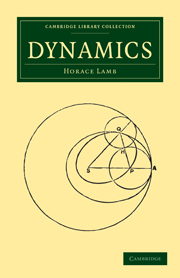Book contents
- Frontmatter
- PREFACE
- Contents
- CHAPTER I KINEMATICS OF RECTILINEAR MOTION
- CHAPTER II DYNAMICS OF RECTILINEAR MOTION
- CHAPTER III TWO-DIMENSIONAL KINEMATICS
- CHAPTER IV DYNAMICS OF A PARTICLE IN TWO DIMENSIONS. CARTESIAN COORDINATES
- CHAPTER V TANGENTIAL AND NORMAL ACCELERATIONS. CONSTRAINED MOTION
- CHAPTER VI MOTION OF A PAIR OF PARTICLES
- CHAPTER VII DYNAMICS OF A SYSTEM OF PARTICLES
- CHAPTER VIII DYNAMICS OF RIGID BODIES. ROTATION ABOUT A FIXED AXIS
- CHAPTER IX DYNAMICS OF RIGID BODIES (CONTINUED). MOTION IN TWO DIMENSIONS
- CHAPTER X LAW OF GRAVITATION
- CHAPTER XI CENTRAL FORCES
- CHAPTER XII DISSIPATIVE FORCES
- CHAPTER XIII SYSTEMS OF TWO DEGRESS OF FREEDOM
- APPENDIX. NOTE ON DYNAMICAL PRINCIPLES
- INDEX
CHAPTER IV - DYNAMICS OF A PARTICLE IN TWO DIMENSIONS. CARTESIAN COORDINATES
Published online by Cambridge University Press: 07 September 2010
- Frontmatter
- PREFACE
- Contents
- CHAPTER I KINEMATICS OF RECTILINEAR MOTION
- CHAPTER II DYNAMICS OF RECTILINEAR MOTION
- CHAPTER III TWO-DIMENSIONAL KINEMATICS
- CHAPTER IV DYNAMICS OF A PARTICLE IN TWO DIMENSIONS. CARTESIAN COORDINATES
- CHAPTER V TANGENTIAL AND NORMAL ACCELERATIONS. CONSTRAINED MOTION
- CHAPTER VI MOTION OF A PAIR OF PARTICLES
- CHAPTER VII DYNAMICS OF A SYSTEM OF PARTICLES
- CHAPTER VIII DYNAMICS OF RIGID BODIES. ROTATION ABOUT A FIXED AXIS
- CHAPTER IX DYNAMICS OF RIGID BODIES (CONTINUED). MOTION IN TWO DIMENSIONS
- CHAPTER X LAW OF GRAVITATION
- CHAPTER XI CENTRAL FORCES
- CHAPTER XII DISSIPATIVE FORCES
- CHAPTER XIII SYSTEMS OF TWO DEGRESS OF FREEDOM
- APPENDIX. NOTE ON DYNAMICAL PRINCIPLES
- INDEX
Summary
Dynamical Principle.
The ‘momentum’ of a particle is the product of the mass, which is a scalar quantity, into the velocity, and is therefore to be regarded as a vector, having at each instant a definite magnitude and direction. The hodograph of the particle may in fact be used to represent, on the appropriate scale, the variations in the momentum.
The ‘change of momentum’ in any interval of time is that momentum which must be compounded by geometrical addition with the initial momentum in order to produce the final momentum. In other words it is the vector difference of the final and initial momenta.
The ‘impulse’ of a force in any infinitely small interval δt is the product of the force into δt; this again is to be regarded as a vector. The ‘total’ or ‘integral,’ impulse in any finite interval is the geometric sum of the impulses in the infinitesimal elements δt of which the interval in question may be regarded as made up.
The fundamental assumption which we now make, is the same as in Art. 7, but in an extended sense. It asserts that change of momentum is proportional to the impulse, and therefore equal to the impulse if the absolute system of force-measurement be adopted. This is, as before, a physical postulate which can only be justified by a comparison of theoretical results with experience. It is a statement as to equality of vectors, and accordingly implies identity of direction as well as of magnitude. It is immaterial whether the interval of time considered be finite or infinitesimal; the statement in either form involves the other as a consequence.
- Type
- Chapter
- Information
- Dynamics , pp. 69 - 97Publisher: Cambridge University PressPrint publication year: 2009First published in: 1923

